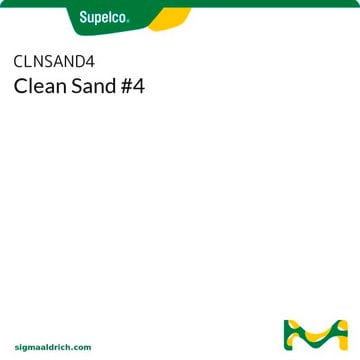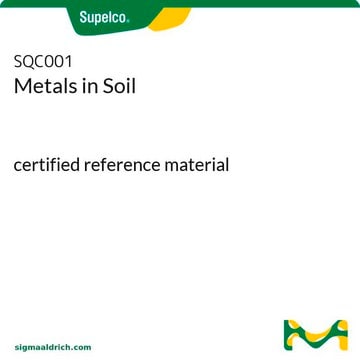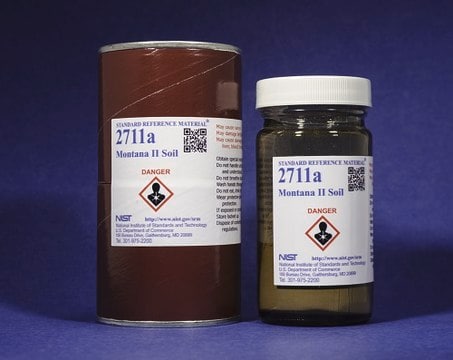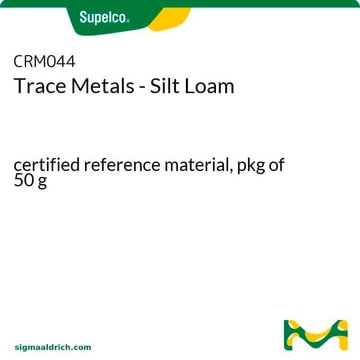CRM048
Trace Metals - Sand 1
certified reference material, pkg of 50 g
Sign Into View Organizational & Contract Pricing
All Photos(1)
About This Item
UNSPSC Code:
41116107
NACRES:
NA.24
Recommended Products
grade
certified reference material
CofA
current certificate can be downloaded
packaging
pkg of 50 g
manufacturer/tradename
RTC CRM048-050
technique(s)
AAS: suitable
ICP: suitable
pH
5.57
application(s)
environmental
format
matrix material
storage temp.
2-30°C
General description
This Certified Reference Material (CRM) is produced and certified in accordance with ISO 17034 and ISO/IEC 17025. All information regarding the use of this CRM can be found on the certificate of analysis.
This product was produced and certified from a naturally contaminated matrix and has not been fortified or modified in any way. Analytical data for Certification was obtained using USEPA SW846, 3rd edition methods 3050 (hot block) and 3051(microwave) using nitric acid extraction. Analysis was carried out according to USEPA methods 6010 (ICP-ES), 6020 (ICP-MS) and 7000 (AES).
Other Notes
Values of analytes vary lot to lot. Some lots may not contain all analytes.
Analyte
Description
Aluminum
Antimony
Arsenic
Barium
Beryllium
Boron
Cadmium
Calcium
Chromium
Cobalt
Copper
Iron
Lead
Magnesium
Manganese
Mercury
Molybdenum
Nickel
Potassium
Selenium
Silver
Sodium
Strontium
Thallium
Tin
Titanium
Vanadium
Zinc
See All (28)
Signal Word
Danger
Hazard Statements
Precautionary Statements
Hazard Classifications
Aquatic Acute 1 - Aquatic Chronic 2 - Carc. 1B - Eye Irrit. 2 - Met. Corr. 1 - Skin Irrit. 2 - Skin Sens. 1
WGK
WGK 3
Choose from one of the most recent versions:
Already Own This Product?
Find documentation for the products that you have recently purchased in the Document Library.
Zuzanna M Filipiak et al.
Ecotoxicology (London, England), 30(3), 459-469 (2021-02-23)
In this study, the effects of zinc nanoparticles (ZnO-NPs) and ions (ZnCl2) on the mortality, growth, maturation, and cellular respiration of the earthworm Eisenia andrei were assessed. Earthworms were individually exposed for 98 days, starting from the juvenile stage, to
Kaja Rola
Journal of trace elements in medicine and biology : organ of the Society for Minerals and Trace Elements (GMS), 61, 126512-126512 (2020-04-17)
Heavy metals that pass through the plasmalemma are expected to influence on lichen metabolic processes; however, lichens may tolerate high concentrations of metals by sequestrating them extracellularly. Heavy metal accumulation level fundamentally determine the success of lichens in the colonisation
Our team of scientists has experience in all areas of research including Life Science, Material Science, Chemical Synthesis, Chromatography, Analytical and many others.
Contact Technical Service












